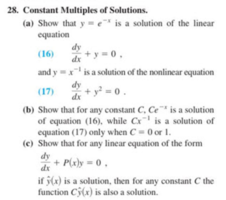Integrate
Junior Member
- Joined
- May 17, 2018
- Messages
- 118
The original full question is here.
28. Constant Multiples of Solutions.
(a) Show that [imath]y = e^{-x}[/imath] is a solution of the linear equation:
(16) [imath]\dfrac{dy}{dx} + y = 0[/imath]
and [imath]y = x^{-1}[/imath] is a solution of the nonlinear equation
(17) [imath]\dfrac{dy}{dx} + y^2 = 0[/imath]
(b) Show that for any constant [imath]C[/imath], [imath]Ce^{-x}[/imath] is a solution of equation (16), while [imath]Cx^{-1}[/imath] is a solution of equation (17) only when [imath]C=0[/imath] or [imath]1[/imath].
(c) Show that for any linear equation of the form
[imath]\qquad \dfrac{dy}{dx} + P(x)y = 0[/imath]
if [imath]\hat{y}(x)[/imath] is a solution, then for any constant [imath]C[/imath] the function [imath]C\hat{y}(x)[/imath] is also a solution.
So I solved the linear differential to get 1/(x-c) and have set them equal to one another.
Where I get c(c-x+1) and I see that that c and c+1 are roots. I'm not sure if this is the right direction.
When searching the answer online I am giving this as a solution.

I understand that we can plug in to get (cx^-1)^2 but why is it d/dx(c^x-1) why is it not dy/dx(cx^-1)?
And in this solution an ln is introduced of which I have a hard time following.

Am I on the right track?
28. Constant Multiples of Solutions.
(a) Show that [imath]y = e^{-x}[/imath] is a solution of the linear equation:
(16) [imath]\dfrac{dy}{dx} + y = 0[/imath]
and [imath]y = x^{-1}[/imath] is a solution of the nonlinear equation
(17) [imath]\dfrac{dy}{dx} + y^2 = 0[/imath]
(b) Show that for any constant [imath]C[/imath], [imath]Ce^{-x}[/imath] is a solution of equation (16), while [imath]Cx^{-1}[/imath] is a solution of equation (17) only when [imath]C=0[/imath] or [imath]1[/imath].
(c) Show that for any linear equation of the form
[imath]\qquad \dfrac{dy}{dx} + P(x)y = 0[/imath]
if [imath]\hat{y}(x)[/imath] is a solution, then for any constant [imath]C[/imath] the function [imath]C\hat{y}(x)[/imath] is also a solution.
So I solved the linear differential to get 1/(x-c) and have set them equal to one another.
Where I get c(c-x+1) and I see that that c and c+1 are roots. I'm not sure if this is the right direction.
When searching the answer online I am giving this as a solution.

I understand that we can plug in to get (cx^-1)^2 but why is it d/dx(c^x-1) why is it not dy/dx(cx^-1)?
And in this solution an ln is introduced of which I have a hard time following.

Am I on the right track?
Attachments
Last edited by a moderator:

